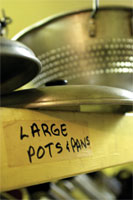In-Depth
Case Study: Switch in time saves online
- By Kathleen Ohlson
- May 1, 2005

Ace Mart Restaurant Supply learned a valuable lesson about Web analytics—choose
the right product the first time. The restaurant supplier, which has been in
business for 28 years, currently rakes in more than $60 million in annual revenues.
Restaurants, ranging from large national chains to Mom-and-Pops, make up 80
percent of Ace Mart’s 60,000 customers. Ace Mart started selling goods
online about four years ago and now offers approximately 4,000 products from
companies such as Hamilton Beach, Gold Medal and Rubbermaid.
Ace Mart wanted to duplicate its success on the brick-and-mortar side on the
Web using online marketing campaigns which included paid search and text banners.
It also placed ads on sites such as Google and Overture. The initial response
was strong, but there was a hitch: Ace Mart couldn’t tell who was visiting
its site and who was buying.
The problem started when the company settled on a Web analytics ASP, which
it selected in part because of its lower price, says Ryan Rodkey, Webmaster
at Ace Mart.
Taking the cost-effective route proved to be costly for Ace Mart. According
to Rodkey, Ace Mart “hit the ceiling” when the Web analytics ASP
failed to deliver accurate campaign reporting and visitor profiles. |
“The sales were going in, but the customers were coming and going out
the door,” Rodkey says. “There was no way to gauge the ads and assess
how they’re working. We couldn’t tell if they bought restaurant
equipment and supplies because they saw the [placement] ad about a toaster or
[the reverse]…. We didn’t know the browsing-to-buying ratio.”
After a year, Ace Mart switched to Coremetrics Online Analytics service in
April of 2004, although not without some pain. Online Analytics “boiled
down” customer data to an individual, granular level, enabling Ace Mart
to view finite orders: who placed an order and where visitors browsed, according
to Rodkey.
The painful part of switching vendors was losing a year’s worth of stored
data because the company wasn’t able to import the data into Online Analytics.
“If you’re faced starting from scratch… it’s important
to re-evaluate the price tag,” Rodkey says. “You don’t think
of that until an issue comes up.… You make a sound choice up front and
put the price tag on the data, not on the cost of the application. You pay for
the application with actionable data.”
Once Ace Mart ramped up with Online Analytics, the supply retailer implemented
changes to its online strategy. First, Ace Mart eliminated more than 50 percent
of low-performing keywords from its paid search campaigns. Out of 800 leading
pay-per-click keywords, it found more than 50 percent of them drove traffic
to the Ace Mart site but didn’t result in sales.
Ace Mart also canceled its entire online banner advertising campaign. It started
delivering an XML feed of its products to a marketing partner, which built the
text banner ads and included them in major search provider results. Ace Mart
discovered only 32 percent of the visitors from these campaigns actually bought
an item.
The restaurant supplier saw an increase in traffic and revenue by redirecting
ads and keywords, fixing misspelled keywords and correcting ads that delivered
visitors to the wrong place. All of the changes helped Ace Mart shave 25 percent
of its marketing costs.
Ace Mart’s analytics team, which Rodkey leads, starts every day logging
into Coremetrics Online Analytics service to look at customer data for its Web
site, tracking sale trends, daily traffic, what categories are doing well and
then making necessary changes. For example, Web analytics helps Ace Mart track
trends for holiday items. “It usually holds true for next year, and we
market for that channel,” Rodkey says.
“It’s a never-ending circle,” Rodkey says, earning Ace Mart
an average 15 percent to 30 percent growth rate per month online.
Back to feature: Special
Report: Web Analytics
About the Author
Kathleen Ohlson is senior editor at Application Development Trends magazine.